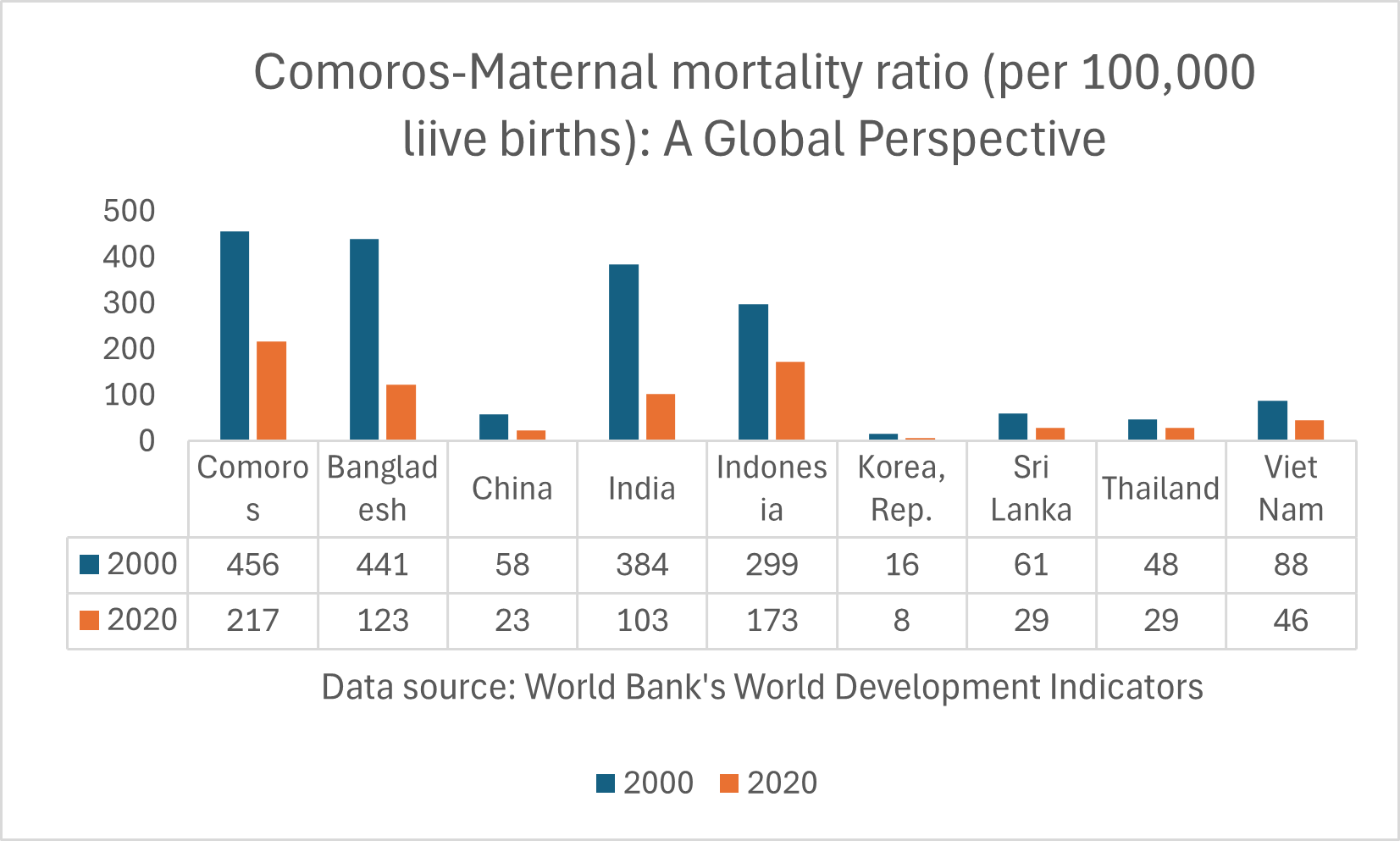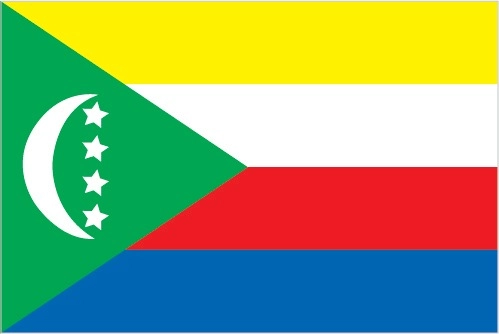
Comoros
Country Flag Details
four equal horizontal bands of yellow (top), white, red, and blue, with a green isosceles triangle based on the hoist; centered within the triangle is a vertical white crescent moon with the convex side facing the hoist and four white, five-pointed stars placed vertically in a line between the points of the crescent; the horizontal bands and the four stars represent the four main islands of the archipelago – Mwali, N’gazidja, Ndzuwani, and Mahore (Mayotte – department of France, but claimed by Comoros)
note: the crescent, stars, and color green are traditional symbols of Islam
Background
The archipelago of the Comoros in the Indian Ocean, composed of the islands of Anjouan, Moheli, and Grande Comore, declared independence from France on 6 July 1975.
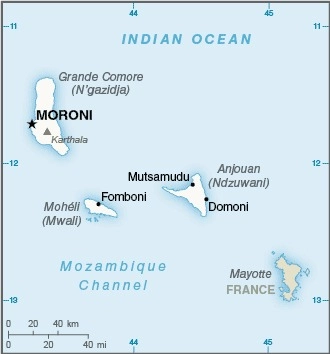
Geography
Area
total : 2,235 sq km
land: 2,235 sq km
water: 0 sq km
Climate
tropical marine; rainy season (November to May)
Natural resources
fish
People and Society
Population
total: 900,141
Ethnic groups
Antalote, Cafre, Makoa, Oimatsaha, Sakalava
Languages
Arabic (official), French (official), Shikomoro (official; similar to Swahili), Comorian
Religions
Muslim 98.1% (overwhelmingly Sunni Muslim, small Shia Muslim and Ahmadiyya Muslim populations), ethnic religionist 1.1%, Christian 0.6%, other 0.3% (2020 est.)
Population growth rate
1.3% (2024 est.)
Government
Government type
federal presidential republic
Capital name: Moroni
Executive branch
chief of state: President AZALI Assoumani (since 26 May 2016)
head of government: President AZALI Assoumani (since 26 May 2016)
Economy
Economic overview
small trade-based island economy; declining remittances; new structural and fiscal reforms; adverse cyclone and COVID-19 impacts; manageable debts; fragile liquidity environment; large foreign direct investment; state-owned enterprises suffering
Real GDP (purchasing power parity)
$2.975 billion (2023 est.)
$2.889 billion (2022 est.)
$2.816 billion (2021 est.)
Real GDP per capita
$3,500 (2023 est.)
$3,500 (2022 est.)
$3,400 (2021 est.)
Exports
$148.455 million (2023 est.)
$166.032 million (2022 est.)
$128.331 million (2021 est.)
Exports – partners
Indonesia 25%, India 23%, Turkey 16%, UAE 11%, USA 3% (2023)
Exports – commodities
cloves, ships, essential oils, vanilla, scrap iron (2023)
Imports
$504.036 million (2023 est.)
$480.268 million (2022 est.)
$415.965 million (2021 est.)
Imports – partners
China 24%, UAE 21%, Tanzania 12%, France 7%, India 6% (2023)
Imports – commodities
refined petroleum, poultry, rice, flavored water, additive manufacturing machines (2023)

Export structure by product group in 2023 ( % of total exports) (UNCTAD)
The export structure of a country includes the range, composition, and monetary value of its international trade in goods and services, providing important insights into the nation’s economic strength, competitiveness, and development level. In the case of Comoros, its export structure is primarily reliant on agricultural products, most notably cloves, vanilla, and ylang-ylang. This focus on specific commodities shapes Comoros’ trade identity, yet it is crucial for the nation to pursue diversification strategies and rectify trade imbalances to ensure long-term sustainable economic growth.

Poverty and vulnerable employment in Comoros
In 2023, 57 percent of total employment in Burundi was categorized as vulnerable employment, which is characterized by insufficient job security, low wages, and a lack of social protections such as health insurance, pensions, or labor rights. This category typically encompasses own-account workers, who operate independently without employees, such as street vendors and small-scale farmers, as well as contributing family workers, who assist in family businesses or farms without receiving formal pay. Such positions are often informal and unstable, failing to provide essential benefits, thereby leaving workers highly vulnerable to economic shocks, exploitation, and poverty. The ramifications of vulnerable employment reach beyond individual workers, affecting families and communities, and creating cycles of instability and hardship that are difficult to break.
Understanding poverty level significance at $2.15 per day
In 2014, 19 percent of the population in Comoros lived in poverty at $2.15 per day. The poverty level at $2.15 per day (measured in 2017 purchasing power parity, or PPP) is a key global benchmark used by the World Bank to define extreme poverty in low-income countries. It indicates:
1. Basic Survival Threshold
• People living below $2.15 per day struggle to afford essential needs such as food, clean water, shelter, healthcare, and education.
2. Economic Underdevelopment
• A high percentage of a country’s population living below this threshold suggests low economic productivity, high unemployment, and weak social safety nets.
3. Inequality and Social Vulnerability
• It reflects deep income inequality and a lack of access to opportunities for upward mobility.
• People in this category are more vulnerable to shocks like food price increases, climate disasters, or health crises.
4. Policy Challenges
• Governments need targeted interventions such as social welfare programs, job creation, and improved access to education and healthcare to reduce poverty.
A country's export structure is a reflection of its level of development and productive capacities
The export structure of a country refers to the composition, diversity, and value of the goods and services it sells to other countries. It provides key insights into the country’s economic health, competitiveness, and level of development. Productive capacities of a country refer to its ability to produce goods and services efficiently and sustainably over time. These capacities are shaped by various factors, including human capital, natural resources, infrastructure, private sector, development, technology & innovation, institutions & governance, financial systems trade & market access.
Here’s what the export structure and productive capacities of a country typically indicate:
- Level of Economic Development
- Developed economies usually export high-value manufactured goods, technology, and services.
- Developing economies often rely on raw materials, agricultural products, or low-value manufactured goods.
- Industrial and Sectoral Strengths
- A strong presence of high-tech or industrial goods (e.g., machinery, electronics) suggests a well-developed manufacturing sector.
- A dominance of commodities (e.g., oil, minerals, agricultural products) indicates reliance on natural resources.
- Export Diversification
- A diverse export base (multiple industries) makes a country’s economy more stable and resilient to global price shocks.
- A concentrated export base (few key products) makes it vulnerable to market fluctuations.
- Trade Partnerships and Dependence
- If exports are heavily dependent on a single country or region, the economy is more exposed to geopolitical and trade risks.
- A wide range of trading partners indicates stronger global integration.
- Competitiveness and Value Addition
- Exporting mainly raw materials (e.g., crude oil instead of refined petroleum) suggests limited industrial processing capacity.
- A high share of finished and high-tech goods suggests strong value addition and competitiveness.
Comoros-Sanitation
Comoros- Proportion of population served with at least basic sanitation
In 2022, the proportion of the population served with at least basic sanitation for Comoros was 32.1 %. Proportion of population served with at least basic sanitation of Comoros increased from 23.5 % in 2000 to 32.1 % in 2019 an absolute increase of 8.6 percentage points (pp) between 2000 and 2022.
Comoros – Proportion of urban population served with at least basic sanitation
In 2010, the proportion of the urban population served with at least basic sanitation for Comoros was 45.5 %. The proportion of the urban population served with at least basic sanitation in Comoros increased from 43.9 % in 2000 to 45.5 % in 2010 an absolute increase of 1.6 pp between 2000 and 2022.
Comoros – Proportion of rural population served with at least basic sanitation
In 2022, proportion of rural population served with at least basic sanitation for Comoros was 35.9 %. The proportion of the rural population served with at least basic sanitation in Comoros increased from 29.2 % in 2000 to 35.9% in 2022, an absolute change of 6.7 pp between 2000 and 2022
Comoros- Proportion of total population served with at least basic sanitation
The ongoing lack of safe sanitation is a critical challenge that demands immediate and united action, resulting in preventable deaths for hundreds of thousands each year and highlighting a major public health crisis requiring urgent attention. Access to safe sanitation is a fundamental human right that should be guaranteed to everyone. In 2022, around 500 thousand people, or nearly 68 percent of Comoros’s population, suffered from inadequate sanitation facilities, starkly contrasting with countries like Vietnam, China, and Thailand, which reported only 8 percent, 5 percent, and 1 percent lacking these essential services, respectively. The global average for individuals without proper sanitation is approximately 6 percent, underscoring the need for collaborative efforts to improve sanitation access in underserved regions of Sub-Saharan Africa, where the impacts are most severe.
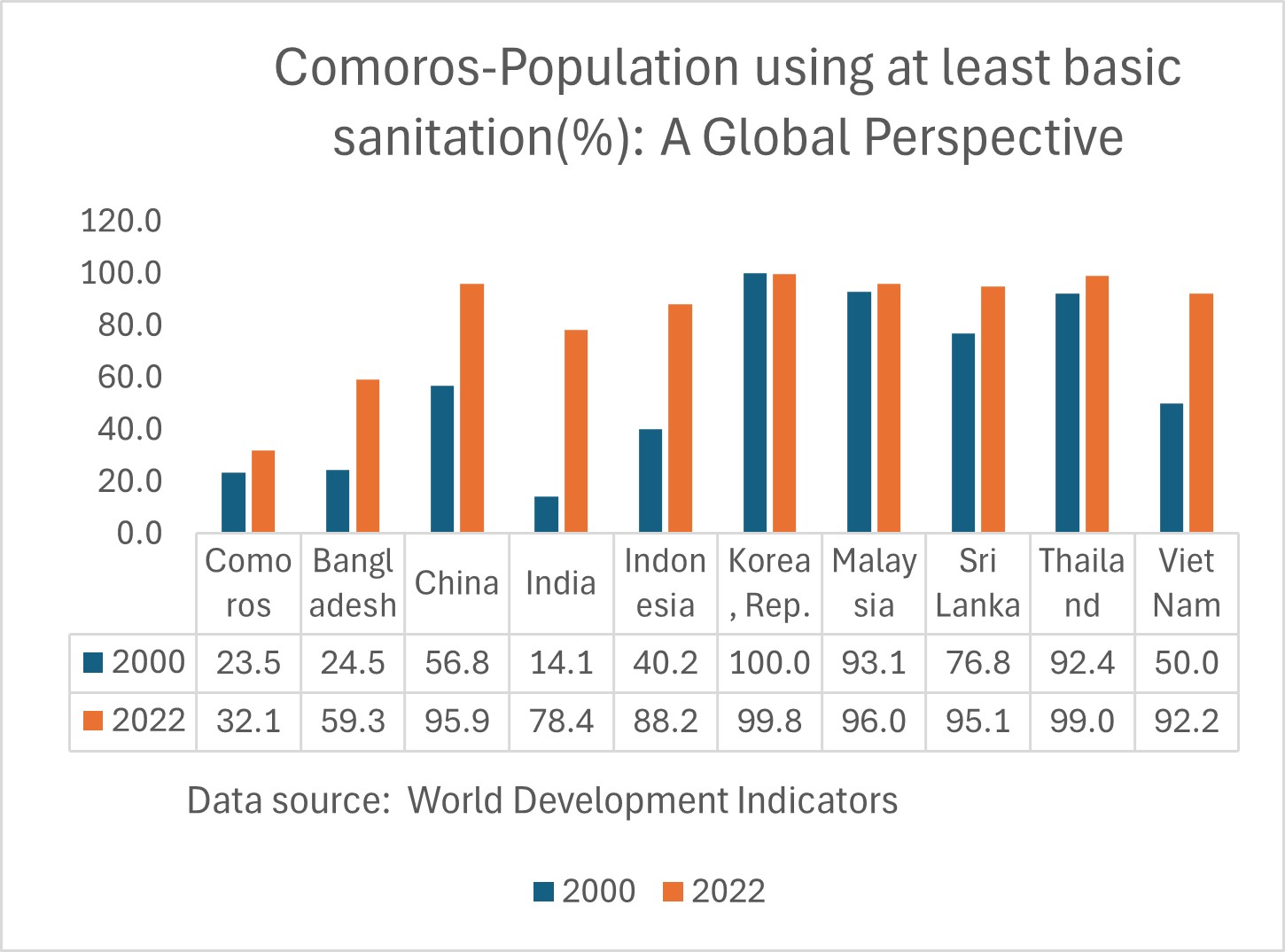
Comoros- Proportion of Rural population served with at least basic sanitation
In 2022, nearly four hundred thousand people in the rural areas of Comoros, about 64 percent of the population, faced the harsh reality of lacking basic sanitation facilities, in stark contrast to countries like Vietnam, Sri Lanka, and Thailand, where the figures were notably lower at twelve percent, five percent, and two percent respectively. This critical lack of safe sanitation demands our urgent attention, as it contributes to countless preventable deaths each year and intensifies a significant public health crisis. Safe sanitation is not just a necessity; it is a fundamental human right that everyone deserves. We must unite in solidarity to advocate for this vital right across Sub-Saharan Africa, where the need is urgent and the potential for transformative community change is crucial to preserving dignity and ensuring health, safety, and respect for all.
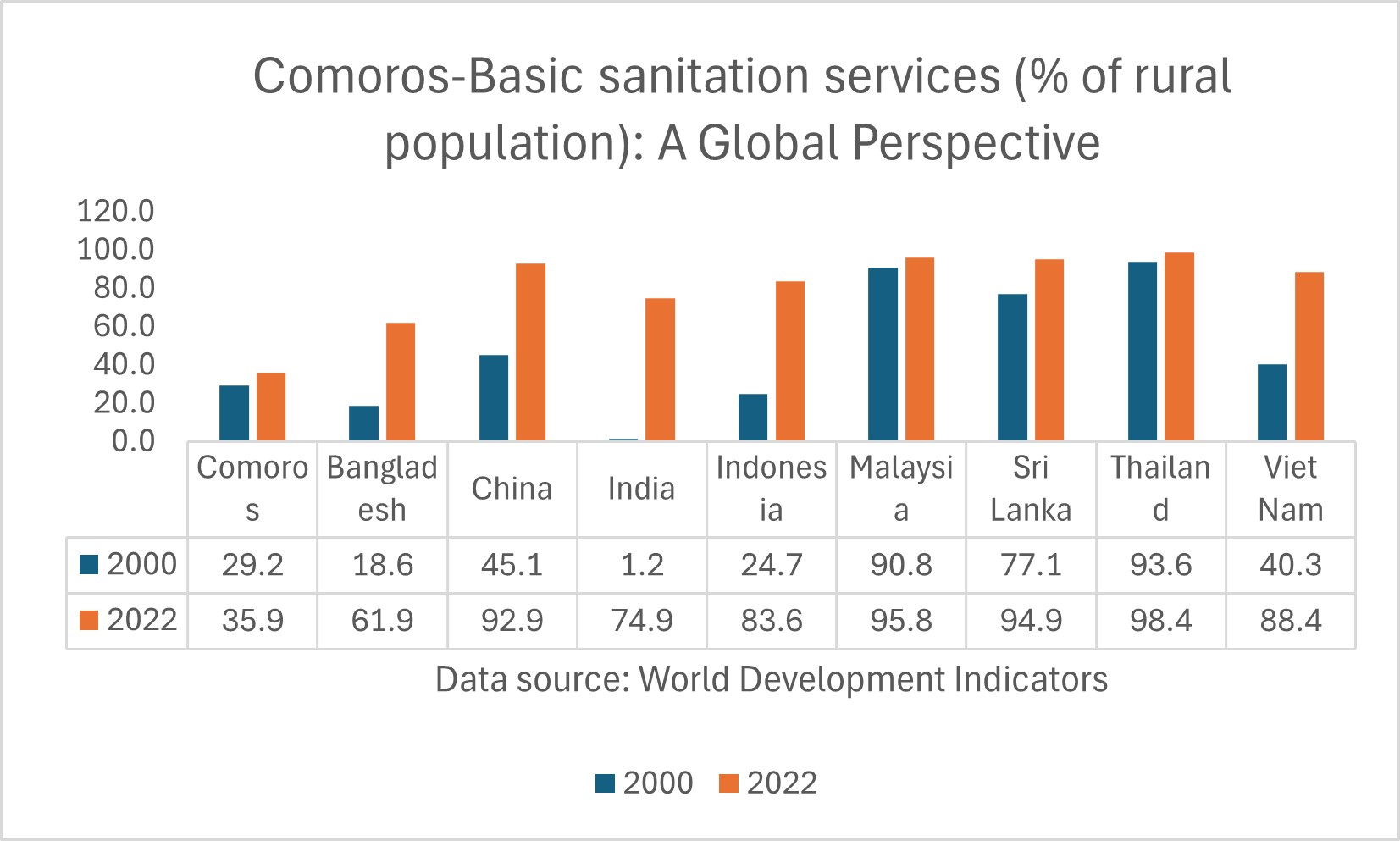
Comoros-Water Supply
Comoros – Proportion of total population served with at least basic water
In 2022, proportion of population served with at least basic water for Comoros was 80.2 %. The proportion of the population served with at least basic water in Comoros declined from 90.9 % in 2000 to 80.2 % in 2019, an absolute change of 10.7 pp between 2000 and 2022.
Comoros – Proportion of urban population served with at least basic water
In 2022, the proportion of urban population served with at least basic water for Comoros was 88.2 %. The proportion of the urban population served with at least basic water in Comoros fell gradually from 89.7 % in 2000 to 88.2 % in 2022, an absolute change of 1.5 pp between 2000 and 2022.
Comoros – Proportion of rural population with at least basic water
In 2022, the proportion of the rural population served with at least basic water for Comoros was 76.9 %. Between 2000 and 2022, the proportion of the rural population served with at least basic water in Comoros declined from 91.5 % in 2000 to 76.9 % in 2022, an absolute change of 14.6 pp between 2000 and 2022.
Comoros – Proportion of total population served with at least basic drinking water: A Global Perspective
Access to safe drinking water is a fundamental human right that requires urgent action from all sectors worldwide. In 2019, over 170 thousand people in Burundi, about 20 percent of the population, were deprived of this vital resource, revealing a serious public health crisis. In stark contrast, everyone in Thailand and 98 percent of people in Vietnam and Bangladesh had reliable access to safe drinking water that year. This inequality highlights the need for reforms in Sub-Saharan Africa, the only developing region where many lack the essential resources to enhance their quality of life. We must intensify our efforts to close this gap and ensure access to safe drinking water for all, as this issue represents a moral responsibility we share as a global community, calling for our commitment to sustainable solutions for a more equitable future.
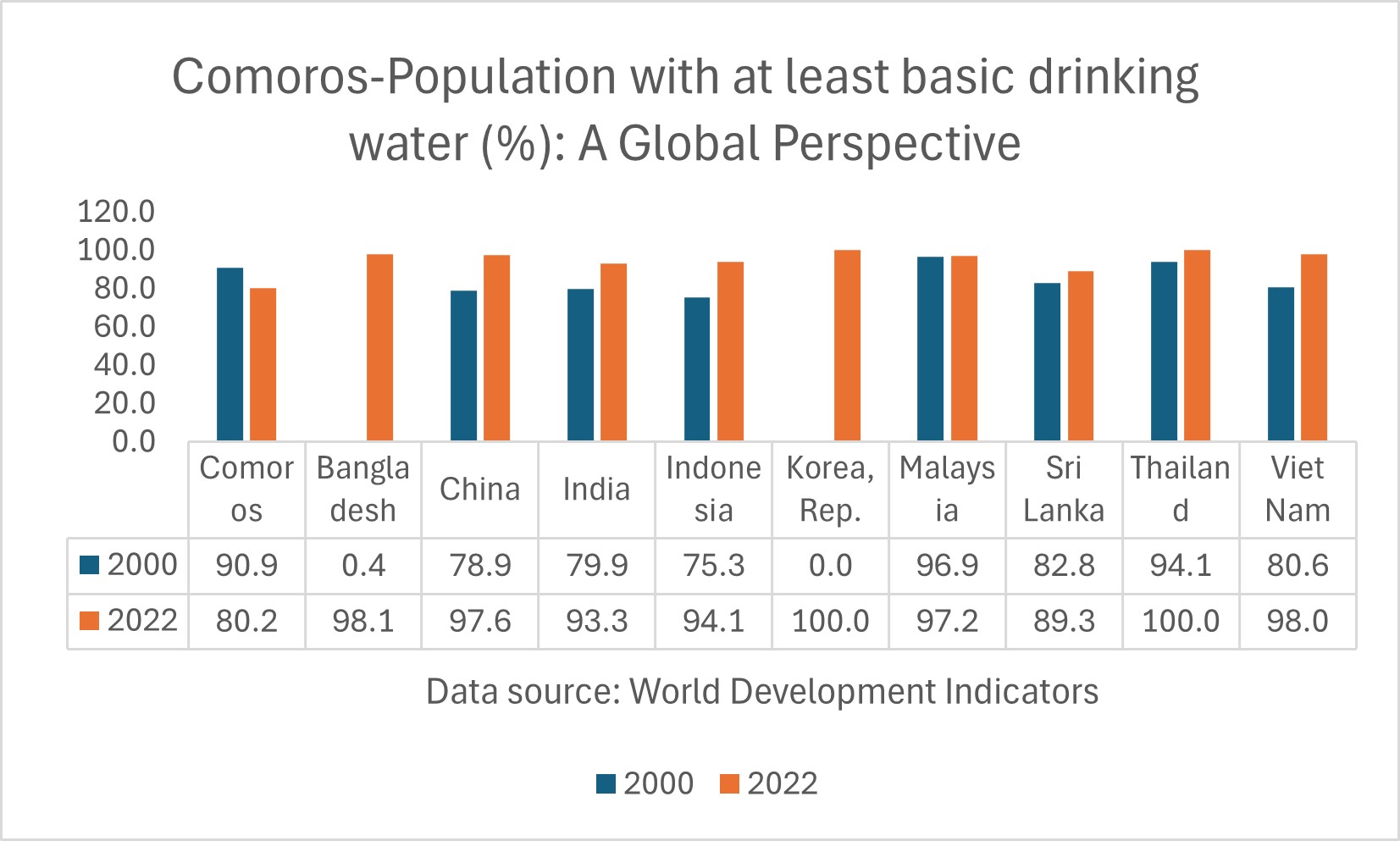
Comoros – Proportion of rural population served with at least basic water: A Global Perspective
In 2022, it is troubling that 23 percent of the rural population in Comoros, around 137 thousand individuals, lack reliable access to safe drinking water, highlighting a humanitarian crisis that demands immediate action from local and international communities. In contrast, countries like Thailand, Bangladesh, and Vietnam have achieved significant progress, with nearly all of their rural populations—100 percent, 98 percent, and 97 percent respectively—having access to this vital resource. This disparity underscores the governance challenges faced by many Sub-Saharan African nations and emphasizes the urgent need for collaborative efforts to improve living conditions and ensure access to essential resources for vulnerable populations who suffer the consequences of inadequate clean water access.

Comoros-Access to Electricity
Comoros-Access to electricity (% of population)
In 2022, proportion of population with access to electricity for Comoros was 89.9 % in 2022. The proportion of population with access to electricity of Comoros increased from 39.8% in 2000 to 89.9% in 2022, an absolute change of 50.1pp between 2000 and 2022.
Comoros-Access to electricity (% urban population)
In 2022, proportion of urban population with access to electricity for Comoros was 100%. The proportion of urban population with access to electricity of Comoros increased from 64.4% % in 2000 to 100% in 2022, an absolute change of 25.6pp between 2000 and 2022.
Comoros-Access to electricity (% of rural population)
In 2022, proportion of rural population with access to electricity for Comoros was 82.9 %. The proportion of rural population with access to electricity of Comoros increased from 30.2 % in 2000 to 82.9% in 2022, an absolute change of 52.7pp between 2000 and 2022.
Comoros- Total population with access to electricity (% of population): A Global perspective
In 2022, it was encouraging to see that only 10 percent of Comoros’ population lacked access to electricity, equating to 85 thousand individuals out of 850 thousand, indicating significant progress in this resilient nation within Sub-Saharan Africa. This achievement starkly contrasts with the low access rates in neighboring countries like Burundi, Angola, and the Democratic Republic of Congo, where rates are just 10.3 percent, 48.5 percent, and 21.5 percent respectively. This disparity highlights the urgent need for reforms across the region and reflects the ongoing struggles of many in Sub-Saharan Africa advocating for better living conditions. The lack of reliable electricity presents serious challenges to development, public health, education, and economic empowerment, which are vital for improving quality of life and creating a sustainable future for these populations.
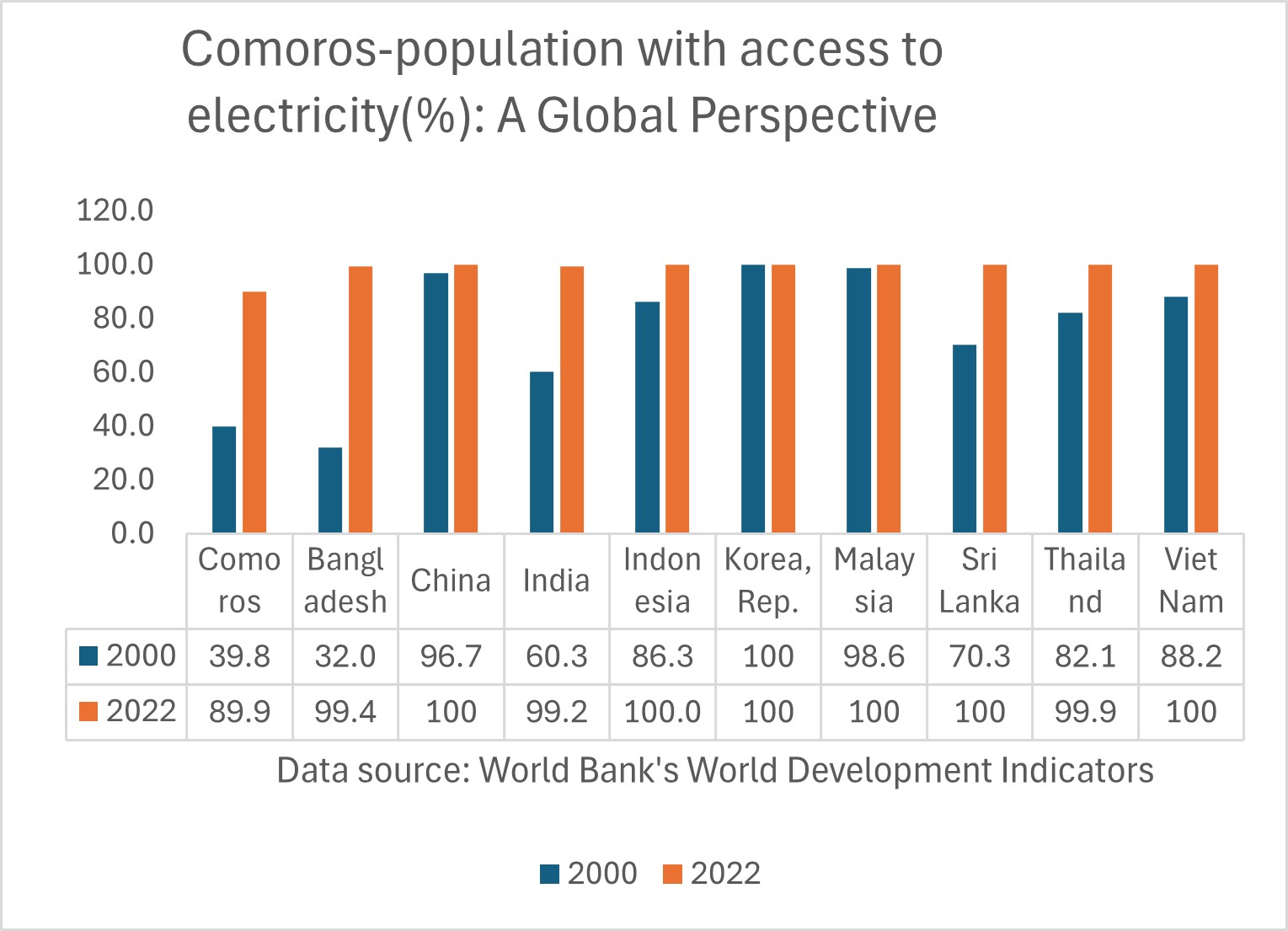
Comoros- Rural population with access to electricity (% of rural population): A Global perspective
In 2022, an alarming 17 percent of the rural population in Comoros, nearly 100,000 individuals, lived without electricity, highlighting a significant disparity compared to countries like Vietnam, Thailand, and Sri Lanka, where all rural residents have full access to this vital resource. Even in India and Bangladesh, an impressive 99 percent of rural populations enjoy reliable electricity, emphasizing the urgent need for equitable energy access in Sub-Saharan Africa. These compelling statistics reflect a critical demand for transformative governance reforms across the region to ensure every community has dependable electricity and is supported in achieving growth towards a more sustainable and prosperous future.
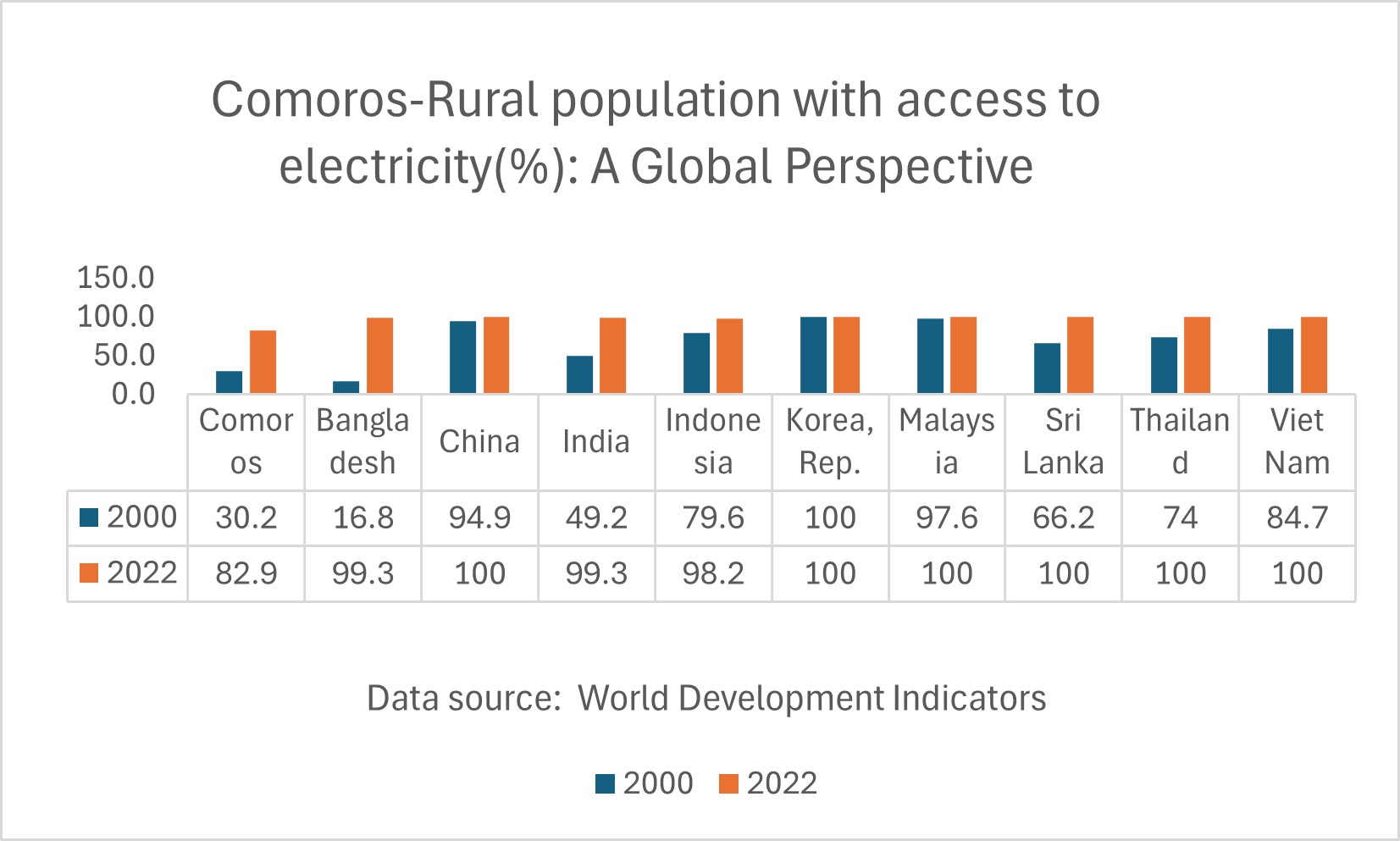
Comoros- Health outcomes
Comoros- Life expectancy: A Global Perspective
As we examine life expectancy trends over the past seven decades, it is clear that while significant progress has been made in increasing both lifespan and health, notable disparities persist, especially in Sub-Saharan Africa. Between 1950 and 2021, the global average life expectancy at birth rose dramatically from 47 to 71 years; however, many Sub-Saharan countries have shown only slight improvements. For example, Comoros’ life expectancy increased from 40 years in 1960 to 64 years in 2022, highlighting ongoing challenges in the region. In contrast, nations like South Korea and the Maldives have achieved extraordinary growth, with life expectancy jumping from 54 years in 1960 to 83 years in 2022 and from 39 years in 1960 to 81 years in 2022, respectively. The low life expectancy rates in numerous Sub-Saharan countries reflect complex issues, including widespread poverty and inadequate healthcare systems, underscoring the urgent need for transformative measures to ensure that the benefits of global development are distributed equitably across all communities.
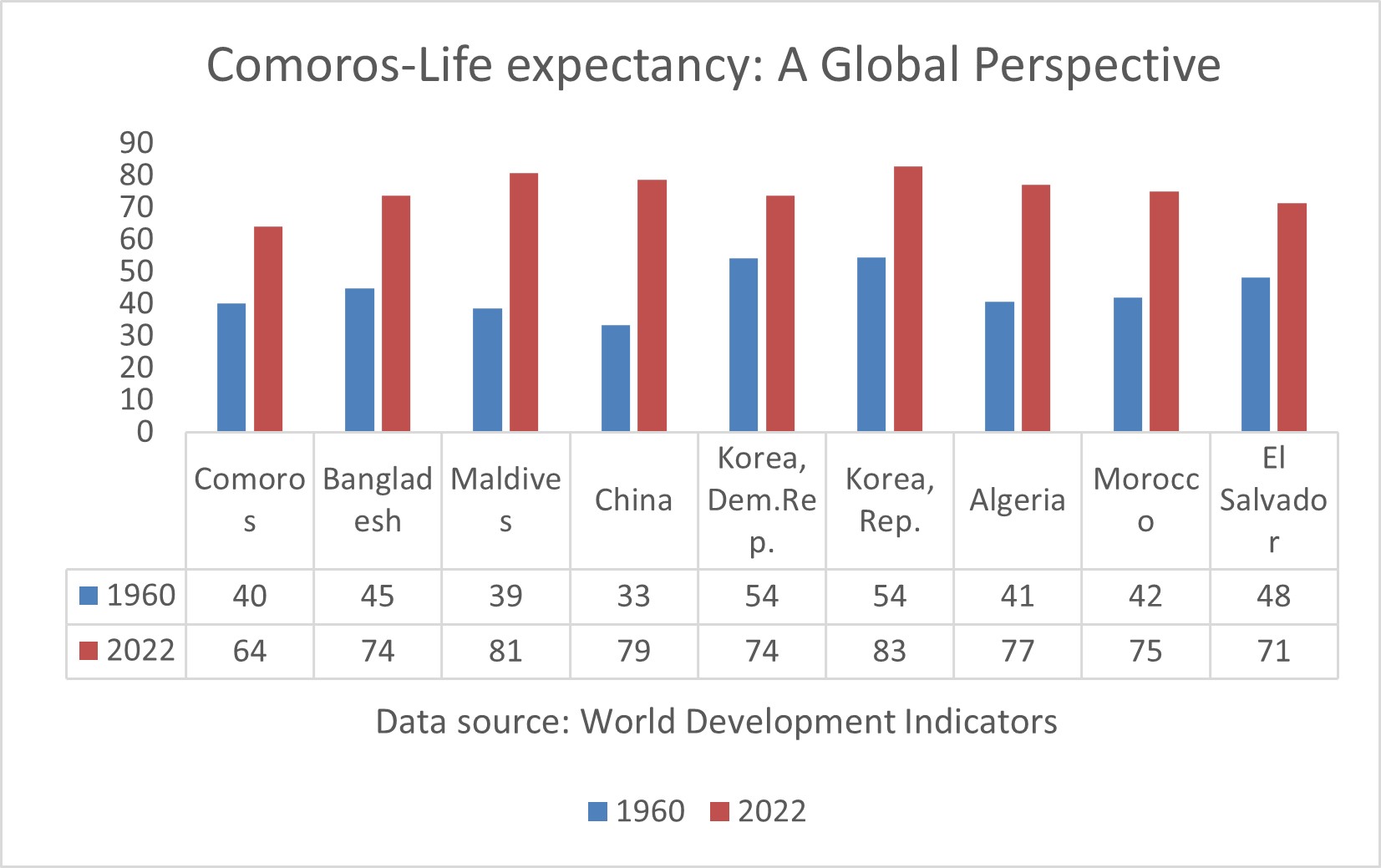
Comoros-Under -5 mortality rate (per 1000 live births): A Global Perspective
Since 1950, child mortality rates worldwide have significantly declined, largely due to improvements in living standards, access to healthcare, better nutrition, and safe drinking water. In affluent nations like those in Europe and America, rates have dropped to below four percent, showcasing the benefits of strong healthcare systems and socioeconomic stability. While many developing countries in South America, Asia, and Africa have made progress, numerous Sub-Saharan African nations continue to struggle. For example, the under-five mortality rate in Comoros has fallen from 176 in 1980 to 48 in 2022. Bangladesh and India, on the other hand, have seen remarkable reductions, with rates plummeting from 206 to 29 and from 169 to 29 respectively. These figures highlight the ongoing challenges of inadequate healthcare and the urgent need for structural reforms in governance across Sub-Saharan Africa to effectively address child mortality and improve health outcomes for vulnerable populations, reinforcing the need for international collaboration and investment in sustainable health initiatives.

Comoros-Maternal mortality ratio rate (per 100,000 live births): A Global Perspective
Comoros’ maternal mortality ratio has notably declined from 456 in 2000 to 217 in 2020 but remains alarmingly high, underscoring the significant risks and challenges mothers face nationwide. This progress is starkly contrasted by the much lower rates in Bangladesh, India, and Vietnam, which reported ratios of 123, 103, and 46 in 2022, respectively. These disturbing figures reveal a crisis where pregnancy-related deaths persist, driven by a high birth rate and ongoing maternal health issues that require immediate intervention. Additionally, they expose severe deficiencies in the healthcare system and the chronic underfunding affecting many Sub-Saharan African nations. The considerable disparities in maternal health outcomes compared to other developing regions highlight the urgent need for investment in health infrastructure and resources, leaving the lives and well-being of mothers and their children in Comoros vulnerable and precarious, a situation that is both unacceptable and preventable.
